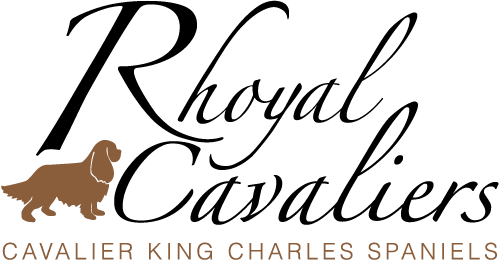Size
Cavaliers stand about 12-13 inches tall and are between 13-18 pounds. Cavaliers are a slow maturing breed and can sometimes surprise people that it can take up to 2-3 years for a Cavalier to be fully matured, males sometimes up to 4 years. They don't continue to grow in height, but rather fill out to acquire a more mature look.
Coat
A Cavaliers coat should be moderately long and silky, free from curl, although a slight wave is permissible. Cavaliers have long feathering on their ears, chest, legs, feet, and tails. They are meant to be a natural breed, which does not require trimming.
Color
Cavaliers come in four colors, tricolor, Blenheim (red and white), black and tan, and ruby. The tricolors have jet black markings on a pearly white background, with tan markings over the eyes, on the cheeks, inside the ears, and on the underside of the tail. Their ears are black, and should have a white blaze between their eyes. Blenheims have rich chestnut markings on a pearly white background. Their ears should be chestnut and a white blaze between their eyes. Black and tans are jet black with rich tan markings above their eyes, on their cheeks and muzzle, inside of ears, across their chest and down their legs, and on the underside of the tail. Rubys are a solid rich red.
Care
Cavaliers do not require a lot of grooming, a nice brushing weekly and regular bathing will keep your cavaliers coat looking at its best. Trimming the toenails monthly is usually enough. It is important to remember their teeth as well; brushing daily can prevent serious health issues. Start when they are young to get them used to grooming and being pampered, before you know it they will be begging for it.
Health
It is very important to remember that every breed has health issues. That is why it is necessary for you to research all health related concerns of the breed you are considering adding to your family. Cavaliers are relatively healthy and sturdy little dogs. As with any breed, there are a few health concerns that you should educate yourself on.
Please be advised that not all breeders are breeding for the same purposes. A reliable breeder will do the necessary health testing prior to breeding. Yet it is important to understand that even if the sire and dam have been screened and found clear of any health problems, no breeder can guarantee that your puppy will never develop a problem during its lifetime. Screenings are done on adult dogs to lessen the chance of health related concerns. Not all breeders believe in all testing, or having tests certified, but they should not object to providing copies of any testing that has been done. Reliable breeders care and are pleased that you care about the health of your new family member.
Cavaliers are generally healthy little dogs that enrich the lives of those who have the pleasure of owning one. To learn more about Cavalier health, please visit the Cavalier King Charles Spaniel Health Foundation and AboutCavalierHealth.com.
Heart Murmurs
Mitral valve disease, known as MVD, is a common heart disease in dogs, affecting smaller dogs as they get older. In the Cavalier, MVD can affect young and old dogs. This is believed to be genetic, affects the mitral valve which is responsible for the correct blood flow from the atria to the ventricles.This is something that should be checked regularly at your annual visits by your veterinarian. As a breeder it is a must to have regular veterinary exams, and to have the Cavalier Heart Certified annually.
Syringomyelia (SM)
A condition that has always been in the breed, as well as other large and small breeds, is syringomyelia. Its symptoms vary drastically, thus a diagnosis was not made until recently. It is thought the condition is similar to Arnold-Chiari malformation, in humans. Based on current theory, of which many holes exist, the bottom half of the skull develops in a way that crowds the cerebellum of the brain, impeding the path of cerebrospinal fluid movement around the brain and spinal cord. The increased pressure and pooling of cerebrospinal fluid may cause irritation and damage to the spinal cord, resulting in symptoms of neck scratching, headache, and in extreme cases, paralysis. Dogs suffering life effecting symptoms of SM are rare.
Eye Defects
Occasionally Cavaliers can suffer from Hereditary Cataract (HD) and Multifocal Retinal Dysplasia (MRD). It is important as a breeder to have the adult dogs certified by a ophthalmologist prior to breeding. Learn more about Canine Eye Registration Foundation exams here.
Luxating Patella
This occurs in the back leg, the groove that holds the kneecap in place is too shallow, allowing the knee to slip out of place. It can cause the dog discomfort and if severe may require surgery for correction. Your veterinarian can examine the kneecaps, upon physical exam, and can tell if your dog has this condition. Luxating Patella's is common in small breeds, but should be cleared by a veterinarian prior to breeding.
Hip Dysplasia
Being a small breed this is not a common problem but can occur as the dog progresses to a senior. No indication of this disease is evident in young dogs and can only be diagnosed by x-rays of the hip joints.

